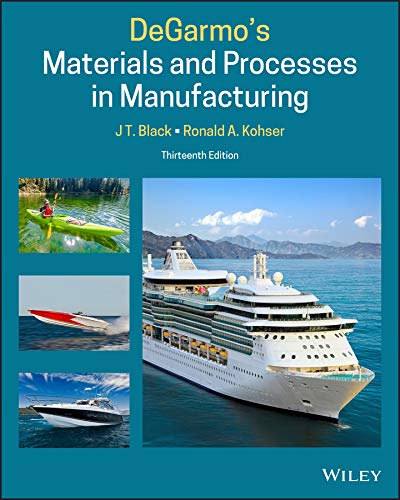
Concept explainers
What are the six activities that are conducted on almost every manufactured product?
The activities performed to manufacture a product.
Explanation of Solution
The processing of the material is a sequence of operations used by applying science and technology to convert the semi-finished goods into useful material. The cycle of operation includes steps like, industrial, chemical, and mechanical through which the material is converted into useful goods with a characteristic shape and desired properties. Thus, it is an engineering process of converting raw material into finished goods.
A series of activities performed onto the material during its manufacturing. There are mainly six activities that are performed on almost every manufactured product and they are:
- Design: It is the first step of the manufacturing process in this the initial design of the final product is made.
- Material selection: After completion of the design, the next step is selecting the proper material to obtain the best final product.
- Process selection: The process includes the type of operation or method used to produce the product.
- Manufacture: After selecting the method the manufacturing of the product is started by using the same process.
- Inspection and evaluation: It includes inspecting the material produced through the above-mentioned process and evaluating its features accordingly.
- Feedback: This is the final step in manufacturing any product. In this step, the feedback of every aspect includes during the entire processing is taken into consideration.
Thus, these are some common activities that are performed on every manufactured product or material.
Want to see more full solutions like this?
Chapter 13 Solutions
Degarmo's Materials And Processes In Manufacturing
- Why is it important to make standards in the manufacture of various engineering materials?arrow_forwardWhat are the advantages and disadvantages of producing new products in existing facilities?arrow_forwarda.. How does the selection of materials impact overall productivity in manufacturing processes?arrow_forward
- Why do we need to measure the product regarding to the physical properties that is in a rapid and accurate manner?arrow_forwardAnalyzee...How does the selection of materials impact overall productivity in manufacturing processes?arrow_forwardCourse: Computer Aided Manufacturing How to explain about part classification and coding system?arrow_forward
- Describe working and environmental conditions that lead to failure for a product made from material from each of the four material categories.arrow_forwardWhat six instructions in the paper mill lead to the manufacturing of the design?arrow_forwardc. The life of a manufactured product is assumed to have gone through eight (8) stages. List and explain all stages using diagrams where necessary.arrow_forward
- What are the key components of a regular maintenance schedule for a complex manufacturing system?arrow_forward26.1. What are the factors affecting the selection of manufacturing processes?arrow_forwardName the four activities often included within the scope of advanced manufacturing planning?arrow_forward
 Elements Of ElectromagneticsMechanical EngineeringISBN:9780190698614Author:Sadiku, Matthew N. O.Publisher:Oxford University Press
Elements Of ElectromagneticsMechanical EngineeringISBN:9780190698614Author:Sadiku, Matthew N. O.Publisher:Oxford University Press Mechanics of Materials (10th Edition)Mechanical EngineeringISBN:9780134319650Author:Russell C. HibbelerPublisher:PEARSON
Mechanics of Materials (10th Edition)Mechanical EngineeringISBN:9780134319650Author:Russell C. HibbelerPublisher:PEARSON Thermodynamics: An Engineering ApproachMechanical EngineeringISBN:9781259822674Author:Yunus A. Cengel Dr., Michael A. BolesPublisher:McGraw-Hill Education
Thermodynamics: An Engineering ApproachMechanical EngineeringISBN:9781259822674Author:Yunus A. Cengel Dr., Michael A. BolesPublisher:McGraw-Hill Education Control Systems EngineeringMechanical EngineeringISBN:9781118170519Author:Norman S. NisePublisher:WILEY
Control Systems EngineeringMechanical EngineeringISBN:9781118170519Author:Norman S. NisePublisher:WILEY Mechanics of Materials (MindTap Course List)Mechanical EngineeringISBN:9781337093347Author:Barry J. Goodno, James M. GerePublisher:Cengage Learning
Mechanics of Materials (MindTap Course List)Mechanical EngineeringISBN:9781337093347Author:Barry J. Goodno, James M. GerePublisher:Cengage Learning Engineering Mechanics: StaticsMechanical EngineeringISBN:9781118807330Author:James L. Meriam, L. G. Kraige, J. N. BoltonPublisher:WILEY
Engineering Mechanics: StaticsMechanical EngineeringISBN:9781118807330Author:James L. Meriam, L. G. Kraige, J. N. BoltonPublisher:WILEY





